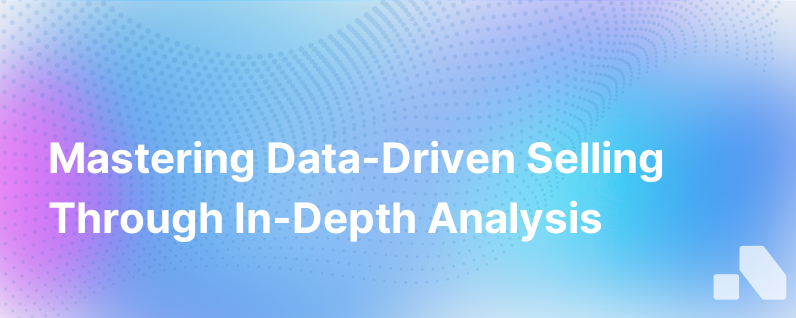Foundations Of Data Driven Selling Analyze
Published on September 29, 2023 by David Zhang
In the high-speed world of sales, adopting a data-driven approach can be the difference between an average quarter and smashing your targets. The complexity of selling environments is increasing, and those organizations without a strong foundation of data analysis could find themselves adrift in a sea of missed opportunities and dwindling returns. Here we'll dive into the essentials of data-driven selling and how it can transform your sales force into a performance powerhouse.
Understanding Data-Driven Selling
Data-driven selling is, at its core, the practice of leveraging data to make informed decisions at every step of the sales process. It encompasses collecting, analyzing, and acting on data to improve sales performance and customer engagement. This systematic approach ensures decisions are not rooted in assumptions or intuition, but in insights gathered from robust data analysis.
The Cornerstones of Data-Driven Selling
1. Data Collection and Management
Before any analysis can occur, collecting high-quality and relevant sales data is crucial. This data comes from various sources such as CRM systems, sales interactions, customer feedback, social media, and market trends. Effective data management is about more than just storage; it involves organizing, cleaning, and ensuring accessibility for analysis.
2. Analytical Tools and Techniques
Once data is in hand, sales teams require the right tools and techniques to dissect this information meaningfully. Businesses might utilize a range of analytics software, from basic spreadsheet tools to advanced sales intelligence platforms. Techniques can range from simple trend analyses to sophisticated predictive modeling, shedding light on past performance and forecasting future results.
3. Sales Metrics and KPIs
Key performance indicators (KPIs) and metrics serve as the North Star for a sales team. They provide a quantifiable measure of progress and success, aligning sales activities with broader business goals. Common KPIs include lead conversion rates, average deal size, sales cycle length, and customer lifetime value.
Building a Data-Driven Sales Culture
Instilling a data-first philosophy within a sales organization requires a cultural shift, well beyond implementing new tools or techniques. Sales leaders must champion the value of data, educate teams on its importance, and encourage the consistent utilization of data in daily activities. It is a comprehensive effort to integrate data analysis into the very fabric of the sales process.
Implementing Data-Driven Strategies
The transition to data-driven selling may seem daunting, but it need not be. Here's how to instill analytics into your sales efforts effectively:
Step 1: Establish Clear Objectives
Identify what you aim to achieve with your sales data. Do you want to optimize lead generation, develop personalized selling strategies, or better understand the customer's buying journey? Setting clear objectives helps delineate what data to collect and analyze.
Step 2: Collect and Integrate Data
Bring together all relevant data from disparate sources into a single unified system. Ensure that your CRM, marketing automation platform, customer service records, and external research operate cohesively. This integration simplifies analysis and offers a more comprehensive view of the customer.
Step 3: Analyze with Purpose
Deploy analytics tools to sift through your data according to your predefined objectives. Look for patterns, trends, and anomalies that could indicate strengths, weaknesses or opportunities within your selling process. Remember, analyzing for analysis’ sake serves little purpose; insights must be actionable.
Step 4: Drive Action from Insights
Transforming insights into concrete action is the crux of a data-driven approach. Use the results of your analyses to adjust your sales strategies, refine your approaches, and redefine targets or processes where necessary. Ensure that insights flow seamlessly back into the sales process to influence tactics and approaches.
Step 5: Develop Continuous Learning Loops
Sales environments change, and so too should your approach to data. Establish a system of continuous feedback where the results of your data-based actions inform future analyses and strategies. This constant learning loop keeps your sales tactics as dynamic and responsive as the market itself.
The Challenges and Opportunities of Data-Driven Selling
While the upsides of data-driven selling are immense, it is not without its challenges. The sheer volume of data can be overwhelming, and not all data is created equal. Data quality, privacy concerns, and analysis paralysis are just a few of the problems that can arise. However, when approached methodically and with a clear focus, these hurdles can be overcome.
The Road Ahead: Sales Optimization Through AI and Machine Learning
Looking forward, the symbiosis of sales and data will only grow stronger with the advent of artificial intelligence (AI) and machine learning (ML). These technologies can identify patterns, predict outcomes, and personalize customer interactions at a scale impossible for human analysts alone. They are the future of data-driven selling.
In a realm like B2B sales, where Aomni sits at the intersection of sales optimization and artificial intelligence, these principles are not just theory but an everyday practice. Aomni simplifies the execution of data-driven selling with robust tools that integrate real-time account research, competitive insights, and personalized content with zero effort required.
Conclusion
The foundations of data-driven selling offer a structural blueprint for sales organizations aspiring to thrive in the modern landscape. Those who understand and leverage data insights will command the competitive high ground, conversant not only in the language of sales but that of data fluency as well. The insights learned today will pave the way for the strategies of tomorrow, rendering the decision-makers as craftsmen, sculpting success in the silhouette of data.